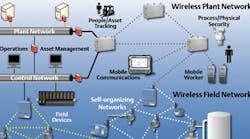There are now about 30 million HART smart devices in service in process plants worldwide. This is nearly double the next largest smart device ecosystem in industrial process automation.
How did this come about? Certainly, the HART Protocol was the first for digital data specifically designed for process automation. Certainly, the fact that the HART Protocol was encoded on top of the standard 4-20 mADC signal and that no wiring changes needed to be made helped. But that was not the real reason for the continuing growth of HART technology. The HART Protocol is simple, easy to understand and use, yet powerful and reliable. "HART devices always work, and always have," says Ron Helson, Executive Director of the HART Communication Foundation.
The HART Ecosystem: Many Vendors, One Standard
"Customers want plug-and-play solutions," says ABB vice president Pat Cashwell. "They don't have the staff or the time to troubleshoot field problems. Additionally, customers do not want to be locked into a single vendor."
"It is very important to us as a vendor of HART devices that interchangeability and interoperability requirements are a fundamental part of the technology," says Endress+Hauser's Robert Bensberg.
Bob Karschnia, Emerson Process Management's vice president for wireless, echoes Bensberg. "As a vendor, what interchangeability and interoperability give is a level playing field…no proprietary connection to a host system. Some might argue that this also commoditizes the products, which is true, but only on one dimension: connectivity. We will add value in different ways to differentiate our products."
HART 7 is More than WirelessHARTTM
There are many new features in HART 7, in addition to the WirelessHARTTM capability. "I believe that all the features of HART 7 are important, including WirelessHARTTM," says Tom Holmes, CEO of MacTek Corp. "We typically include all the features of a major revision that are applicable to our product line, in order to produce the most flexible product possible. For example, with our Bullet WirelessHARTTM adapter, we provide the option to use either loop power or direct power, and the option to multi-drop up to six devices in accordance with the HART Standard."
"We are looking to implement two new features that are part of the HART 7 standard," says Scott Saunders, vice president at Moore Industries International, "even before implementing any wireless capabilities in our transmitters. The first is exception-based reporting, and the second is multiple-message support. Exception-based reporting is critical to diagnostic monitoring systems that our customers have been asking us for, especially since all plants are running with fewer and fewer personnel. Multiple-message support will help eliminate one of the obstacles to multi-dropping HART devices at the relatively slow 1200 bps data rate that many hosts and asset systems still support."
The HART Communication Foundation Holds It All Together
Founded in 1993, the Foundation is the technology owner, standards-setting body and central authority on the HART Protocol and provides global support for application of the HART technology. The Foundation establishes and controls the HART Communication standards, including new developments and technology enhancements that benefit and support the needs of the industry. "At Moore Industries," says Saunders, "we don't sell or manufacture a full-blown control system. Open communication standards like HART are the best solution for us and our customers."
"Unfettered interoperability is our goal for all devices implementing the HART Protocol," says Ed Ladd, Director of Technology Programs for the HART Communication Foundation. "Therefore, the Protocol specifications and Quality Assurance and Device Registration Procedures are all written to ensure the interoperability of HART-enabled products."Since 1993, vendors have been permitted to develop testing procedures on their own and submit the test results to the Foundation. In 2008, the Foundation's board of directors mandated independent verification testing be required to register HART devices, whether wired or wireless.
Ladd continues, "Products undergo many levels of testing, and the test specifications that are outlined in the HART Test Program standardize and eliminate the need for each manufacturer to develop its own test to validate Protocol compliance."
Manufacturers still test their devices, but they use new standardized tests and procedures. Ladd goes on, "Manufacturers must confirm the test results through the Foundation's Quality Assurance and Device Registration Procedure. Manufacturers must perform the tests and certify the results. Then they send a device along with complete documentation to the Foundation for verification. Through independent testing the Foundation performs 100% verification and validates that the device and its test results have achieved the Protocol requirements."
Interoperability and Interchangeability—the Key to HART
"With over 30 million HART-enabled products in the field, HART-enabled solutions must be able to interoperate no matter what revision the device or protocol," says Ladd. "As the number of HART products continue to grow, it has become increasingly more important that all manufacturers ensure their devices are compliant to the HART Protocol Standard, passing all conformance tests and registering products with the Foundation."
"It has always been a requirement," says Helson, "that any HART-enabled device must be able to replace any other similar device, regardless of manufacturer. That means that any new HART 7 device, wired or WirelessHARTTM, is backward-compatible with the entire globally installed base of HART instruments. It also means that HART-enabled devices have a very low risk of failure or bad application, and the cost of ownership is lower because you can reduce inventory. One device can be configured for multiple applications."
"As a vendor of HART multiplexers," says Pepperl+Fuchs' Thomas Klatt, "we have 'only' to ensure that the HART commands will be transferred correctly from the host to the instruments and back." Before P+F began manufacturing WirelessHARTTM devices, Klatt noted, "Interoperability was a very important point to us, because the HART multiplexer is almost always located between different DCS systems and different field instruments."




